
ARCHIVED PAGE - PLEASE READ!
This page was written by me a long, long time ago. As such the quality of the writing, photography and/or any conclusions I may have come to simply do not stand up to the levels I consider necessary these days.
I do not believe in deleting things outright though as I feel that these pages form something of a time capsule from an earlier stage in my life, and may still be of some interest to folks who have been coming here for a long time. So instead of deleting this page it has been archived.
PLEASE NOTE THAT THIS PAGE HAS BEEN ARCHIVED, AND SHOULD BE CONSIDERED "FOR INTEREST ONLY" AND NOT BE USED FOR ANY OTHER PURPOSE. LINKS, PRICING ETC ARE LIKELY TO BE OUTDATED AND WILL NOT BE UPDATED.
Nuwai ALX-113AA. Rating: 88%

The ALX-113AA is another in Nuwai's rapidly increasing range of Luxeon Star based flashlights (They also have a number of 5W models, which aren't seen all that commonly from manufacturers other than specialised ones such as Surefire - Well, weren't in 2004 when this page was written!). It features a 1W low dome Luxeon Star as the light source, with the beam focused by a mirror smooth reflector. A simple push button switch turns the light on and off, the light is of an all metal (aluminium I assume) construction, and is water resistant. A Nylon carrying pouch, wrist lanyard and a set of Duracell Ultra alkaline batteries are included.
Product Info:
Manufacturer: Nuwai.
Available from: N/A - Obsolete Product.
Price (Correct at time of writing in early 2004): £29.99 (Bought on offer for £19.99) (US ~$45).
Size: 23.2cm x 3.35cm.
Number of lamps: 1.
Lamp Type: 1.2W Luxeon Star LED (Low Dome).
Lamp Current: 390mA on new Duracell Ultra Alkaline batteries.
Lamp Colour: White.
Body finishes available: Lightly polished natural aluminium.
Battery type: 3 AA Alkaline. (Supplied).
Switch Type: Push button with tactile click, intermittent off.
Water Resistance: Water resistant, not submersible.
Approximate Beam angle: ~10 Degrees.
Notes: Light comes supplies with Duracell Ultra Alkaline batteries, a nylon carrying pouch and a wrist lanyard.
(Beamshot below is taken from 1 metre, with colour balance set to Daylight)
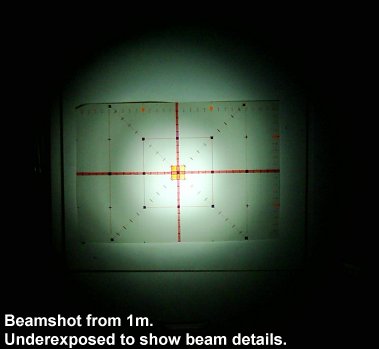
Packing:
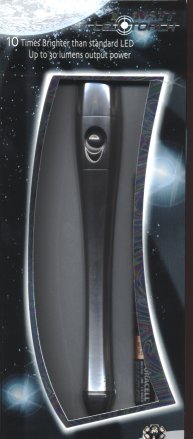
The ALX-113AA is supplied in a sturdy card box with a plastic insert holding the light, batteries and nylon pouch in place. The graphics are typical of those seen on most of Nuwai's newer products, including the use of multi coloured reflective bits to accentuate the lettering and edges of the window around the light itself, and the space theme. It obviously serves its purpose well, as it drew my attention from halfway across the store when I walked into Maplin, despite the fact I wasn't looking for it. Of course, once I'd spotted it, and that it was a new Nuwai light...then it was an LS based unit...it was by that point in my hand, and on the way to the counter.
It's easy to get into, requiring no knives, axes, blowtorches, laser cutters or chainsaws to get into, like some other packaging these days seems to require to gain entry. Just open the flap at the top, get your fingers under the edge of the plastic tray in there, and pull the whole lot out - at which point the nylon pouch will probably land on the floor, as it simply sits underneath the tray. Then all you have to do is lift off the clear plastic cover, lift out the light (hold on to it, it's heavier than it looks), take out the batteries, then put the packing somewhere safe for future reference.
Instructions on the reverse show how to change the batteries, though it is pretty simple. Also, there's a warning not to look into the light from the LED for more than a second or two - which is a very valid warning given how bright this thing is. There's also a little diagram at the bottom showing a comparison of how much light is given out by the LS compared to a standard 5mm LED.
Full size Packing pics: Front Rear
Power Source:
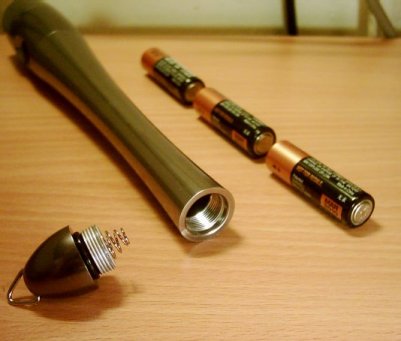
The ALX-113AA feeds from three alkaline AA size cells, which are supplied in the packaging, but require you to fit them to the light before it can be used. In this case, this is not a big deal, as the battery change procedure is very simple. All that you have to do is described in the next paragraph.
1. Unscrew the tailcap - this is probably the hardest part, as the tailcap, like the rest of the light has a smooth finish, and if your hands are at all greasy or wet, getting enough of a hold of it could be tricky.
2. Dump out the expired batteries at this point and dispose of them correctly (if your neighbourhood operates a battery recycling program, stick them in the box for that). If you are fitting the batteries for the first time, needless to say, this step can be skipped over.
3. Obtain three new alkaline AA (LR6), and insert them in the barrel of the light, positive (nipple) end toward the bezel end of the light.
4. Screw the tailcap back on, the joint should be totally flush with the body of the light, this should show you when it's tight enough - don't overtighten it, or you'll probably have a nasty time trying to get it off again.
Battery life is stated as 8 hours, though the light is not regulated as far as I can see (Simply resistored), so that will probably be around eight hours of steadily dimming light. I shall attempt to get a runtime test done at some point in the future, though. Given how bright it is to start with though, I reckon that this thing will be plenty bright for a pretty long time, and the fact that AA batteries are so cheap adds to the economy factor.
Lamps:
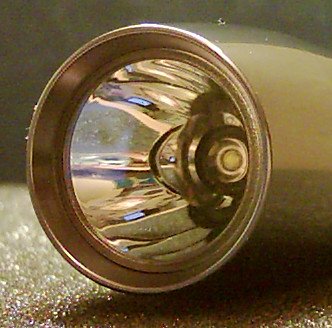
The ALX-113AA features a low dome 1W Luxeon Star LED. This however is one of the newer batches of the Low dome emitters, and has the advantage of the newer EOS phosphor, which is deposited evenly across the surface of the die, rather than just having a blob applied in the die cup. This allows these newer LED's to be slightly more efficient than the older type, also increasing consistency in colour and beam pattern by a very, very large margin compared to the older units (such as used in the CMG Reactor3). The older LED's tended to have a VERY variable beam colour from one unit to the next (even in the same batch often), ranging from very blue or purplish, to a sickly yellow green colour. Someone on Candlepower Forums termed this the "Luxeon Lottery" as it is more than anything else luck which defines what kind of colour the emitter is. The new EOS process, while not eliminating the problem altogether, has stacked the odds somewhat more in your favour. In this case, the LED I have is a pure, almost HID like white, not actually blueish, but a very pure cold white. I've already had one person (Not a lighting fanatic, but who is more than casually curious) who asked me if this was a HID light. A Luxeon star emitter is shown below - the heatsink "Star" (Hence the name), is actually 20mm across, it looks a lot bigger in the photograph. This is actually a High dome emitter, but is just there to show what an LS looks like, the only difference between this and the one in the light is the shape of the clear epoxy lens.
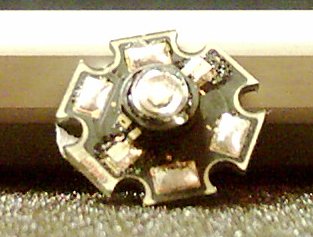
There is no provision made to replace the LED, but given that it's rated to something around 100'000 hours, that isn't all that much of an issue. The LED is slightly overdriven (~400mA on new batteries), but the thermal management arrangement here is decent enough that the LED should be more than able to handle that extra 100mA of current without any significant reduction in lifetime. Even if the lifetime was reduced to half (50K hours), that's still a heck of a long time (Average compact fluorescent lamp's usually rated to something around the 10K hour mark), especially in terms of a flashlight...the chances of the LED ever actually burning out are slim at most.
Performance:
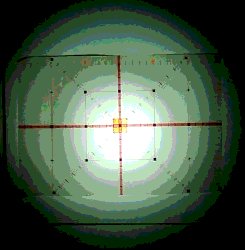
Until this came along, the CMG Reactor 3 was the brightest (Okay, and only) 1W LS based light...this however, blows it clear out of the water!
In simple terms, the ALX-113AA is BRIGHT, very bright. As in comparable to most incandescent flashlights within reason (Roughly equivalent to the incandescent mode on the AN-606 on fresh batteries actually). Shown below to the left is a comparison made between the CMG Reactor 3 and the ALX-113AA, as you can see, there really is very little competition.
As you can see, the ALX-113AA has a very intense hotspot, surrounded by a bright, if rather ringy corona. Generally speaking, a hotspot this intense from an LED light comes at a heavy cost in terms of sidespill - as in, it usually becomes non-existent. This can lead to "tunnel vision" when trying to navigate with a light at night. However, the ALX-113AA has a very good balance between the two, and it's perfect for navigating around inside with, or thanks to the sheer power of the light, navigating outside too. How far the light actually throws, I have no idea, but it must be a fair way.
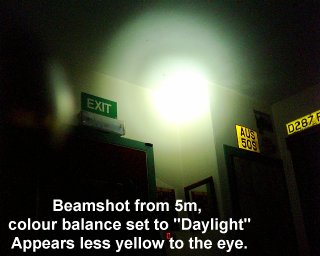
This unit has a slight off-centre hotspot due to the die in the Luxeon Star emitter itself being a little off-centre, this is not a fault of Nuwai, but is a glitch in the manufacturing process of the LED. However, it's not a problem really, and certainly doesn't detract from the usefulness of the light.
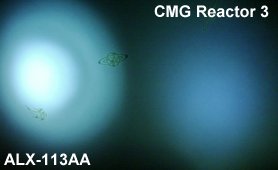
The rings in the beam are primarily due to the combination of a Low Dome emitter and the mirror smooth reflector, there the rings however aren't really apparent unless you shine the light on a plain white surface, and I've all but stopped noticing them now that I've been using the light for a week or so. Nuwai apparently has plans to switch to the use of High Dome emitters in their products in the near future. High Dome emitters tend to work more effectively with reflectors such as this. (As an experiment, I tested this reflector - not attached to the light of course - with the LS shown in the picture shown earlier. The result was a much smoother beam, albeit without quite so intense a hotspot).
The main thing that I notice about this light (and the Reactor3 for that matter) is that they're both bright enough to be truly useful in a very wide variety of situations - this one much more so, as it has so much more throw than the Reactor - which given the difference between the Reactor's 20 degree beam and the ALX-113AA's 10 degree beam isn't really surprising. What is surprising though, is how much more light overall the ALX seems to put out than the Reactor. Admittedly, the ALX does overdrive the LED slightly, and the Reactor underdrive its slightly, but the difference is truly phenomenal. I do not however know what the flux rating of either LS is - so I can't say how much of this difference is due to the LED itself, or the drive current. Apparently though, Nuwai do use quite highly rated emitters though - and CMG reputed to use very average ones in the Reactor - so that could be an issue. This light is capable of lighting a room to pretty reasonable levels by shining it on a white ceiling, the Reactor can too, but the room is much dimmer in that case. I don't have an integrating sphere - and that's my poor man's version for judging overall output levels!
Operation:

See that black rubber covered button? That's all you need to worry about to use this light.
Press and release it to get light, press and release it again to get dark. Couldn't be simpler could it.
The beam focus is preset to a medium spot with plenty of sidespill, and was not designed to be adjusted. It is however possible to adjust it to more of a flood if required simply by unscrewing the bezel a little. However, doing this exposes the O-ring which waterproofs that join, so unscrewing the bezel will negate the water resistance.
The switch is of the intermittent off type, meaning that for signaling, you first turn the light on, then press the button partway in to switch the light off, release to allow it to come back on. Some people like this type of switch, some don't; for the record, I personally don't care, either type of switch works for me.
The switch has a nice and positive audible and tactile "click" when latching in either the on or the off position, and should be possible to use with gloves on, so long as they're not TOO thick. You don't really need the click to tell you the light's on though, it's so bright that you can't really miss the fact!
Ergonomics:
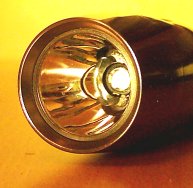
The ALX is a very comfortable light in this area - provided that you don't ever want to hold onto it with wet or greasy hands anyway! The slightly polished finish is really quite slippery if the light gets wet. However, even if it does get wet, the shape of the light, with the narrowest section in the middle, aids at least somewhat in retention. It also helps your thumb to automatically land on the switch, and makes the light all that much more comfortable to hold. There really isn't much else to add to this section! Just try to hang on to it!
Durability Department:
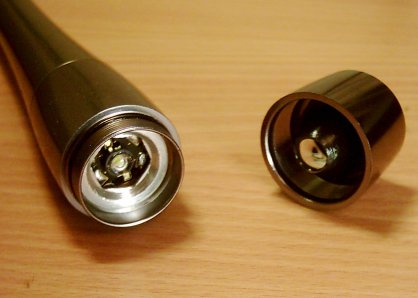
There's no denying that this is a very durable lighting instrument. As flashlights come in the field on indestructibility, this one is up there with the best of them. The first thing that you'll undoubtedly notice about it is that the light has a very significant mass to it, even without batteries inserted. This is a good thing in a couple of ways - one, is that is provides additional heatsinking to keep the LED cool, prolonging its life considerably, and secondly, it shows that the light is very thick walled - as you can see from the pictures in the battery change section. The walls there are nearly 3mm thick, and at the thinnest point, are still around 2mm thick! As you can see in the picture to the left, the bezel itself is of an equally sturdy construction. This is a light that will probably outlive the owner, and can be passed on to the grandchildren - if they still have AA batteries in 70 years time anyway.
The weak point in many flashlights tends to be the switch. This one however, appears to be identical to that used in the other Nuwai lights I have, and feels very positive - I have out of five Nuwai lights - never had any switch trouble with any of them, and I don't think this one will be any exception.
However, every light (generally speaking) has an Achilles' heel. In the case of Nuwai lights, it has generally been - and the ALX-113AA is no exception in this regard - the lens. It's plastic, and quite thin plastic as well. Not to the point that it'll break easily, but the AT-100 and AN-606 both proved that whatever the lens material is, it tends to pick up scratches rather rapidly. Still, as stylish a light as this probably isn't going to find itself thrown into the bottom of a toolbox, and so long as you're reasonably careful, especially if you store the light in the carrying pouch that it was supplied with, you shouldn't have any problems with that.
On the same note, the polished finish, lovely though it does look, is possibly not the best choice from a durability point of view. In general use it'll do fine, but after a few days rolling around in a toolbox or similar place, it'd probably start to get scratched and end up looking sad and uncared for compared to its original self. Who would want to do that to such a nice looking light though?
Water resistance has also been a bit of a hit and miss affair for some of the Nuwai lights. In general, they've been perfectly water resistant in the examples I have - aside from the switch rubber. That's where the water has always got in. The ALX-113AA however, survived a six hour submersion in the bath here without any signs of leakage whatsoever, so it appears that Nuwai have finally got the waterproofing bug sorted.
So, the lens could be better, and the finish maybe a little more durable, however, the chances of the light being damaged to the point of actually failing, as far as I can see are near zero.
Overall:
It's not all that often that the word stylish can be applied to something like a flashlight - but in this case it most certainly can. To me, the ALX-113AA makes me think of the Sci-Fi movies of old, this is what they predicted this kind of thing would look like in the year 2000 - and here we are, in 2004, and yes, we do have flashlights that look like that! To make an analogy of how classy this light looks and feels, if a MagLite was a middle of the range Volkswagen, this would top of the range Mercedes range. Only the beam pattern and plastic lens wrenching the classification of "Rolls-Royce" out of its reach. A Shame really.
However, this is one light that I would recommend to anyone, especially if you have yet to see a Luxeon Star based light in action for yourself. So long as your expectations are realistic, you certainly won't be disappointed. This is a light that's very good value for money, as with most of the Nuwai's I've tested.
Pros:
+Bright!!!
+Uses cheap and easy to find batteries.
+No bulbs to burn out.
+Easy to use.
+Durable.
+Very good beam colour.
+Looks great.
+Very cheap for what it is.
+Feels great in the hand.
+Waterproof (to 3 feet anyway).
Cons:
-Not fully waterproof.
-A little slippery, could be hard to hold on to in adverse conditions.
-That lovely finish could get scratched easily if abused.
-Lens could be better.
Niggles:
>Cannot be stood on tail to light a room by shining on the ceiling. (Some people hate that, I don't care either way myself).
>Overdrives the LED slightly, but the heatsinking seems adequate to handle that, I wouldn't worry about it.
>Beam is a little ringy and off centre.
Ratings:
Beam Quality: 7
Build Quality: 10
Battery Life: 8
Durability: 10
Value: 10
Overall: 44 / 50 = 88%
Long Term Testing:
30.Jan.2004: Uploaded specifications and photographs only, will get review written ASAP.
11.Feb.2004: Uploaded review in full, finalised rating.
3rd August 2009: Updated this page so it works on the new server properly. This light was packed away when I moved in May this year, and was still working well. I did at one point have some problems with flickering and low output - however this was traced to a dodgy contact between the body and the body, and was easily solved by cleaning the threads with some contact cleaner. While LED lights have come a long, long way in the last 5 years, this one's still quite bright enough to be useful in and out doors, and was used quite frequently until I had to thin out which lights I had access to when I moved.
5th January 2021: Page moved to Site Archive.
23rd April 2023: Removed some long, long dead hyperlinks.
28th April 2023: Revised Statcounter code to allow for HTTPS operation.